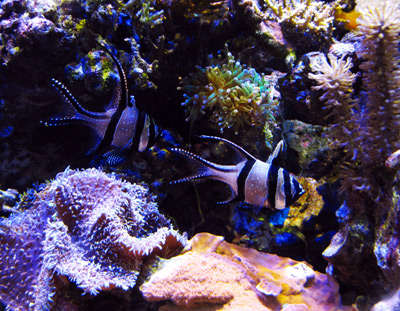Hobby pioneer Paul “Paul B” Baldassano has some strong opinions on what types of foods are best for fish, formed over his many decades of involvement in the marine aquarium hobby. Somewhere near the top of his list is fish (or krill) oil.
From Chapter 3: Keeping Fish Healthy
Oil, in my opinion, is one of the most important things you can feed to fish. No, not Oil of Olay or olive oil, but fish or krill oil. I take it myself every day, but not too much, as I don’t want to resemble my old flounder-faced girlfriend.
In the sea, fish get a large percentage of their diet from pure fish oil. How do I know? Glad you asked. I have been scuba diving since 1970, when I did my first dive on the Great Barrier Reef in Australia. I was on R&R from Vietnam, and I met a girl there who took me to this restaurant where they give you all the dive equipment and throw you in the water. All you had to do was give them any extra fish you speared.
I caught an anemic-looking lobster, and she had a belt full of fish. When we surfaced and started back to shore, I heard machine gun rounds. I knew that sound because a couple days before, I was in a war. I said (not very calmly, I am sure), “What the hell is that?” She replied, “Don’t worry, they are shooting the sharks.” Apparently, sometimes a large shark gets tangled up in this net they have around the harbor, and they shoot it. I understand that there are holes in that net large enough to allow a tractor trailer to “swim” through, and the girl I was swimming with had a belt full of bleeding fish. To this day, that was the fastest I have ever swum.
Anyway, since then I have been diving all over the place and have spent about 200 hours under water. If you’ve done any real diving—the kind where you lie on the bottom by yourself until you run out of air or realize you forgot to remove your cell phone from your Speedo—you may have noticed schools of tiny fish fry, mostly near the substrate. Well, fish fry are like fast-food restaurants for most of the fish on a reef and form a large part of their daily diet. If you watch fish long enough, you will see them dip down often for a snack of fresh fish fry.
All fish have a liver. That liver serves a couple of functions besides cleaning the blood. It also helps with buoyancy, but only slightly in most fish. In sharks, the liver provides all of the buoyancy. Without the oil in their liver, sharks would swim about as well as Paris Hilton’s dog or a cinder block. In fact, the liver is mostly oil and can be 15% of the fish’s weight—almost 20% in sharks.
So think about this: When a fish eats another whole fish, it’s getting almost 15% of its diet as pure fish oil. If a shark eats a 100-pound grouper, it’s getting about 12 pounds of oil. That’s a lot of oil!
Check out the ingredients on a package of dry food and see if there is any oil. Oil doesn’t dry very well, and boy does it stink! So my theory is that fish require a large portion of their diet as oil. It makes sense to me and to the fish.
Also consider that in pregnant fish, the eggs can be almost a third of the weight of the fish, and those eggs are mostly oil. It is a huge burden on a fish to produce those eggs, and many of the correct extra calories are needed to do so. Just imagine how much a woman would have to eat in order to have a 50-pound baby every month!
So where can we get this oil? The best place is in whole fish, but whole tiny fish are not available live or frozen, and I don’t know why. (Tip to fish food manufacturers: Sell tiny frozen fish fry for food!) Fish and krill oil is also sold in capsules, and if I plan to feed my fish flakes or pellets, I always put a drop of fish oil on it first. Pellets soak up oil very well. However, don’t put oil of any kind on wet foods, such as frozen food, as it will just wash off as soon as the food hits the water.



